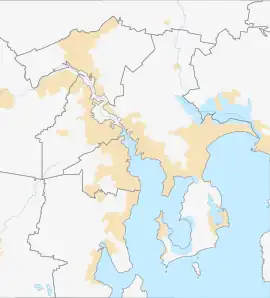Lutana, Tasmania
Lutana is a residential locality in the local government area (LGA) of Glenorchy in the Hobart LGA region of Tasmania. The locality is about 3 kilometres (1.9 mi) south-east of the town of Glenorchy. The 2021 census recorded a population of 2,616 for the state suburb of Lutana.[1] It is a suburb of Hobart. It is a large residential suburb located between the Brooker Highway and the River Derwent.
| Lutana Hobart, Tasmania | |||||||||||||||
|---|---|---|---|---|---|---|---|---|---|---|---|---|---|---|---|
 Lutana is behind Moonah in this view from the west from Lost World. | |||||||||||||||
 Lutana | |||||||||||||||
| Coordinates | 42°50′28″S 147°18′34″E | ||||||||||||||
| Population | 2,616 (2021 census)[1] | ||||||||||||||
| Postcode(s) | 7009 | ||||||||||||||
| Location | 3 km (2 mi) SE of Glenorchy | ||||||||||||||
| LGA(s) | City of Glenorchy | ||||||||||||||
| Region | Hobart | ||||||||||||||
| State electorate(s) | Clark | ||||||||||||||
| Federal division(s) | Clark | ||||||||||||||
| |||||||||||||||
History
Meaning "moon" in one of the Aboriginal Tasmanian languages,[2] Lutana was initially a sparsely populated area with agricultural and rural characteristics. Over time, the suburb underwent development and urbanization, transforming into a residential area.
The oldest properties at Lutana were originally built by Electrolytic Zinc (the operator of the Risdon Zinc Works)[3] as homes for its employees at the nearby zinc works.[4] The homes were later sold off and are now privately owned.
The suburb was gazetted as a locality in 1961.[5]
Lutana has experienced substantial growth in recent years, becoming a popular inner-city suburb, offering a range of housing, including weatherboard homes, townhouses and apartments.
Heavy metal contamination
Trading as Nyrstar Hobart, the Risdon Zinc Works at Lutana, which has been in operation since 1917, continues to produce heavy metal contaminants affecting the air, land and estuary waters surrounding Greater Hobart.[6]
In the 1980s, top soil samples from Lutana, Geilston Bay and Lindisfarne revealed high concentrations of zinc, lead, and cadmium. The sampling also revealed that the prevailing wind directions, the terrain of the land, and proximity to the smelter had an impact on the contamination's dissemination pattern.[7]
Early to mid-1990s soil sampling around Lutana and the eastern shore revealed that increased levels of cadmium, lead, and zinc were confined to the top 50 millimetres (2.0 in) of the soil profile, with the bulk concentrated in the top 20 millimetres (0.79 in).[7]
A 2009 report conducted by the CSIRO recommended that home-grown vegetables vulnerable to the uptake of heavy metals including lettuce, spinach, carrot and beetroot should be grown in raised garden beds with a minimum depth of 30 centimetres (12 in) clean soil.[7]
Drawing from data complied in the National Pollutant Inventory, a report by the Australian Conservation Foundation placed Hobart at number 6 of Australia's most polluted cities in 2018. The data identified medium levels of air pollution in postcodes 7009 (Lutana, Derwent Park, Moonah, West Moonah), 7010 (Glenorchy, Rosetta, Montrose, Goodwood, Dowsing Point) and 7015 (Lindisfarne, Geilston Bay, Rose Bay) with average air contaminate readings of 40% NOx (nitric oxide (NO) and nitrogen dioxide (NO
2)), and sulfur dioxide (SO2) contributing 57% of airborne emissions.[8][9]
The Tasmanian Planning Scheme does not mandate the Glenorchy City Council to notify prospective buyers about potential land contamination within the City of Glenorchy.[10]
Geography
The waters of the River Derwent and New Town Bay form the north-eastern to south-eastern boundaries.[12]
Road infrastructure
National Route 1 (Brooker Highway) passes to the south-west, and several roads provide access to the locality.[5][13]
References
- Australian Bureau of Statistics. "2021 Census Quick Stats Lutana (Tas.)". quickstats.censusdata.abs.gov.au. Retrieved 27 April 2023.
- Howatson, Donald, The Story of New Town – Street by Street, 2011, ISBN 978-0-9871287-1-3
- known originally as the Risdon zinc works
- Ruth Barton. "Communal life, common interests and healthy conditions".
- "Placenames Tasmania – Lutana". Placenames Tasmania. Select "Search", enter "18N", click "Search", select row, map is displayed, click "Details". Retrieved 2 April 2021.
- Obendorf, David (29 May 2006). "From the archives: the State of the Derwent". Tasmanian Times. Retrieved 22 May 2023.
- "Managing Soil Contamination in parts of Lutana and Hobart's eastern shore" (PDF). Environment Protection Authority. 1 May 2009. Retrieved 21 May 2023.
- "The Dirty Truth: Australia's Most Polluted Postcodes" (PDF). Australian Conservation Foundation. 1 November 2018. Retrieved 22 May 2023.
- Hermant, Norman; Clark, Emily (16 November 2018). "Australia's pollution mapped by postcode reveals nation's 'dirty truth'". Australian Broadcasting Corporation. Retrieved 22 May 2023.
- "NOTIFICATION TO PURCHASERS: CONTAMINATED LAND IN LUTANA" (PDF). Glenorchy City Council. 28 March 2022. Retrieved 22 May 2023.
- "The Zinc Works". TChange. Retrieved 11 July 2009.
- Google (2 April 2021). "Lutana, Tasmania" (Map). Google Maps. Google. Retrieved 2 April 2021.
- "Tasmanian Road Route Codes" (PDF). Department of Primary Industries, Parks, Water & Environment. May 2017. Archived from the original (PDF) on 1 August 2017. Retrieved 2 April 2021.

